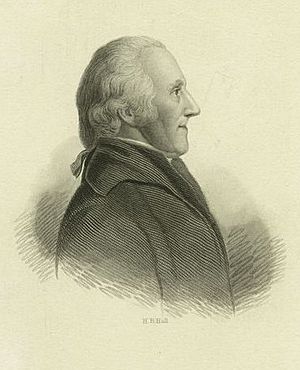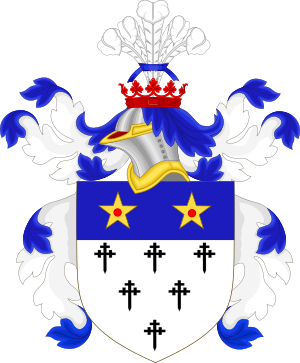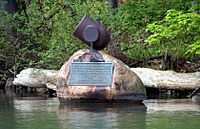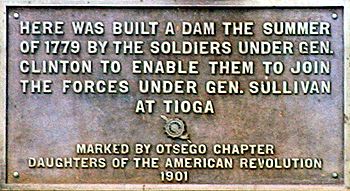James Clinton facts for kids
Quick facts for kids
James Clinton
|
|
|---|---|

1861 sketch of Clinton
|
|
| Born | August 9, 1736 |
| Died | September 22, 1812 (aged 76) Little Britain, New York, United States
|
| Spouse(s) |
Mary DeWitt
(m. 1765; Mary Gray |
| Children | 13, including DeWitt, George, James |
| Parent(s) | Col. Charles Clinton Elizabeth Denniston |
| Relatives | George Clinton (brother) William W Clinton (great-grandfather) James Clinton (grandfather) George W. Clinton (grandson) Ambrose Spencer (son-in-law) |
| Signature | |
James Clinton (born August 9, 1736 – died September 22, 1812) was an important officer during the American Revolutionary War. He is best known for leading the Sullivan Expedition in 1779 with John Sullivan. This mission aimed to attack British-allied Seneca and other Iroquois villages in what is now western New York. Their forces destroyed many villages and their winter food supplies. James Clinton earned the rank of brevet major general, which is an honorary rank.
Contents
Early Life and Family
James Clinton was born in 1736 in Little Britain, a small town in Ulster County, which was then part of the colony of New York. He was the third son of Colonel Charles Clinton. His father was an Anglo-Irish colonist and a colonel who fought in the French and Indian War.
James had a famous brother, George Clinton. George later became the Governor of New York and even the U.S. Vice President. James was also the father of DeWitt Clinton, who would also become a Governor of New York. His family had a long history in the military.
Military Career
Fighting in the French and Indian War
James Clinton's military journey started during the French and Indian War. This war was part of a bigger global conflict called the Seven Years' War. He served in the New York colonial troops, fighting for the British.
He became an ensign in 1757 and a captain in 1759. In 1758, he commanded a company alongside his father and brother George. They helped General John Bradstreet capture Fort Frontenac in what is now Canada. James and George were key in capturing a French ship during this battle.
After the war, Clinton stayed in the army at different frontier posts. In 1763, he led a group of 200 men called "Guards of the Frontier." Later, he left the army and married Mary De Witt.
The American Revolution
A month after the first battles of the American Revolutionary War in Lexington, the Continental Congress decided to build forts in the Hudson Highlands. These forts would protect the important Hudson River. James Clinton helped scout locations for these forts.
In 1775, he became a colonel in the 3rd New York Regiment. This regiment took part in a failed mission to capture Quebec. In 1776, Clinton took command of the 2nd New York Regiment. Soon after, he was promoted to brigadier general in the Continental Army.
Protecting the Frontier
Clinton spent most of the war in the Northern Department, along the New York frontier. During the Saratoga Campaign in 1777, he commanded Fort Clinton in the Hudson Highlands. He tried to stop British General Henry Clinton from helping General John Burgoyne at Saratoga.
However, James Clinton and his troops could not hold Forts Clinton and Montgomery. He was wounded in the leg during the attack. In 1778, he was stationed in Albany to fight against Native American and Tory forces. Loyalists were American colonists who stayed loyal to the British Crown.
The Sullivan Expedition
In 1779, General Clinton led an important expedition down the Susquehanna River. To make the river easier to travel, he built a dam at its source, Otsego Lake. This raised the lake's water level. Then, he destroyed the dam, sending a flood down the river for miles. This event is mentioned in the famous novel The Pioneers.
At Tioga, New York, Clinton joined forces with General John Sullivan. Together, on August 29, they defeated the Loyalists and British-allied Iroquois at the Battle of Newtown. This mission became known as the "Sullivan-Clinton Campaign" or the "Sullivan Expedition." They attacked many Seneca villages in western New York, destroying 40 of them and their winter food supplies. Many Seneca people had to flee to Canada, and many faced hardship that winter.
In 1780, Clinton briefly commanded the Northern Department. By October 1781, his troops joined George Washington's army at the siege of Yorktown. This was one of the final major battles of the war.
After the War
After leaving the army, James Clinton helped define the border between New York and Pennsylvania. In 1783, he became a founding member of the New York Society of the Cincinnati. This was a group for officers who served in the Continental Army.
He also entered state politics. He served as an assemblyman in the New York State legislature from 1787 to 1788 and again from 1800 to 1801. He was also a New York State Senator from 1788 to 1792.
Family Life
On February 18, 1765, James Clinton married Mary DeWitt. They had seven children together, including:
- DeWitt Clinton (1769–1828), who became a famous politician and Governor of New York.
- George Clinton, Jr. (1771–1809), who served as a U.S. representative in Congress.
After Mary's death, James Clinton married Mary Gray. They had six more children, including:
- James Graham Clinton (1804–1849), who also served in Congress.
James Clinton passed away in Little Britain, New York, on September 22, 1812. His brother George also died in the same year.
Through his son DeWitt, James Clinton was the grandfather of George William Clinton (1807–1885), who became the Mayor of Buffalo, New York.




